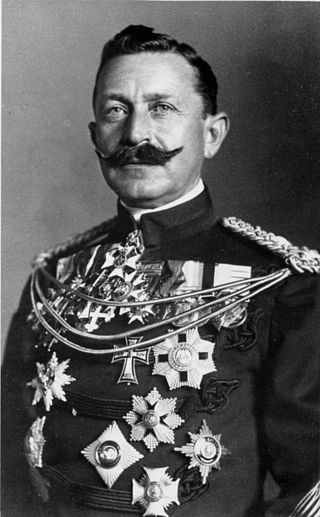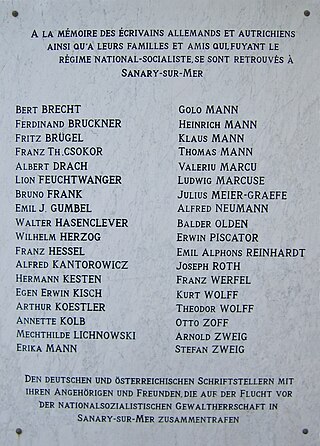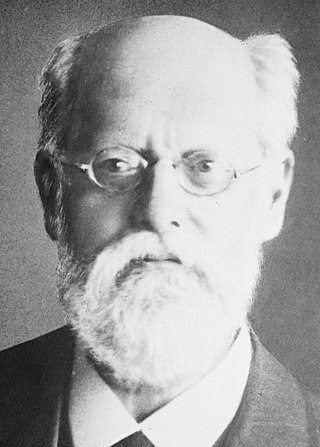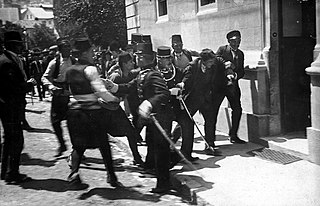Gallery
- Franz Serafin Exner, 1908
- Middlesex Wanderers defending their goal from WAF, Vienna, 1912
- Aeroplane of the Imperial Russian Air Force shot down in September 1914
Carl Seebald (22 August 1878, Vienna - 21 December 1941, Vienna) was an Austrian photographer active in Vienna in the early twentieth century.
Carl (or Karl) was born in Vienna. In 1905 he registered himself as a press photographer and founded the Illustration Company Carl Seebald. He was living at 107 Währingerstraße 107 in Währing, the eighteenth district of Vienna. [1]
During the First World War, from 1914, he was attached to the wartime press headquarters with assignments taking him to Serbia and Russia. His home address was Gäntzgasse 111, still in Währingin 1915 but he moved to Sieveringerstraße 31 in Döbling, the nineteenth district of Vienna until 1918.
By the 1920s he supplemented his work as a press photographer with studio photography. Die Woche published many of his photographs. In 1924, he co-founded the Organization of the Viennese Press, and the Free Association of Press Photo-Reporters from Austria. By 1925 he was living in Weidlingbach and from 1927 he was based at 99 Mariahilferstrasse Mariahilf in the sixth district of Vienna.

Austria-Hungary, often referred to as the Austro-Hungarian Empire, the Dual Monarchy, or Austria, was a constitutional monarchy and great power in Central Europe between 1867 and 1918. It was formed with the Austro-Hungarian Compromise of 1867 in the aftermath of the Austro-Prussian War and was dissolved shortly after its defeat in the First World War.

Max Reinhardt was an Austrian-born theatre and film director, intendant, and theatrical producer. With his innovative stage productions, he is regarded as one of the most prominent directors of German-language theatre in the early 20th century. In 1920, he established the Salzburg Festival with the performance of Hugo von Hofmannsthal's Jedermann.

Karl Weyprecht, also spelt Carl Weyprecht, was an Austro-Hungarian explorer. He was an officer in the Austro-Hungarian Navy. He is most famous as an Arctic explorer, and an advocate of international cooperation for scientific polar exploration. Although he did not live to see it occur, he is associated with the organisation of the first International Polar Year.

Karl Renner was an Austrian politician and jurist of the Social Democratic Workers' Party of Austria. He is often referred to as the "Father of the Republic" because he led the first government of German-Austria and the First Austrian Republic in 1919 and 1920, and was once again decisive in establishing the present Second Republic after the fall of Nazi Germany in 1945, becoming its first President after World War II.

Otto Bauer was one of the founders and leading thinkers of the left-socialist Austromarxists who sought a middle ground between social democracy and revolutionary socialism. He was a member of the Austrian Parliament from 1907 to 1934, deputy party leader of the Social Democratic Workers' Party (SDAP) from 1918 to 1934, and Foreign Minister of the Republic of German-Austria in 1918 and 1919. In the latter position he worked unsuccessfully to bring about the unification of Austria and the Weimar Republic. His opposition to the SDAP joining coalition governments after it lost its leading position in Parliament in 1920 and his practice of advising the party to wait for the proper historical circumstances before taking action were criticized by some for facilitating Austria's move from democracy to fascism in the 1930s. When the SDAP was outlawed by Austrofascist Chancellor Kurt Schuschnigg in 1934, Bauer went into exile where he continued to work for Austrian socialism until his death.

Franz Carl Heimito, Ritter von Doderer; known as Heimito von Doderer was an Austrian writer. He was nominated for the Nobel Prize in Literature five times.
The Christian Social Party was a major conservative political party in the Cisleithanian crown lands of Austria-Hungary and under the First Austrian Republic, from 1891 to 1934. The party was affiliated with Austrian nationalism that sought to keep Catholic Austria out of the State of Germany founded in 1871, which it viewed as Protestant and Prussian-dominated; it identified Austrians on the basis of their predominantly Catholic religious identity as opposed to the predominantly Protestant religious identity of the Prussians.

Major-General Rudolf Anton Carl Freiherr von Slatin, Geh. Rat, was an Anglo-Austrian soldier and administrator in the Sudan.

Nicola Perscheid was a German photographer. He is primarily known for his artistic portrait photography. He developed the "Perscheid lens", a soft focus lens for large format portrait photography.

Simon von Sina or Simon Sinas was a Greek-Austrian banker, aristocrat, benefactor and diplomat. He was one of the most important benefactors of the Greek nation together with Georgios Sinas.

Stjepan Freiherr Sarkotić von Lovćen was an Austro-Hungarian Army generaloberst of Croatian descent who served as Governor of Bosnia and Herzegovina and military commander of Dalmatia and Montenegro during the First World War.

Franz Theodor Csokor was an Austrian author and dramatist, particularly well known for his Expressionist dramas. His most successful and best-known piece is 3. November 1918, about the downfall of the Austria-Hungary monarchy. In many of his works Csokor deals with themes of antiquity and Christianity.

Gerald Stourzh is an Austrian historian who studies modern history, especially the history of North America, of Austria, of political ideas, of constitutions and especially of human rights. He taught, as a professor, at the Free University of Berlin from 1964 to 1969, and at the University of Vienna from 1969 until 1997, when he became professor emeritus.

Maximilian Albert Josef Liebenwein was an Austrian-German painter, graphic artist and book illustrator, in the Impressionist and Art Nouveau styles. He spent significant time in Vienna, Munich and Burghausen, Altötting, and took an active part in the artistic community in all three places. He was an important member of the Vienna Secession, becoming its vice-president, and exhibiting with the group many times.

Karl Johann Kautsky was a Czech-Austrian philosopher, journalist, and Marxist theorist. Kautsky was one of the most authoritative promulgators of orthodox Marxism after the death of Friedrich Engels in 1895 until the outbreak of World War I in 1914.

Alphons Leopold Mielich was an Austrian painter noted for his orientalist scenes. He participated in a team responsible for documenting the frescoes in an Umayyad castle at Qasr Amra, including the famous Painting of the Six Kings and provided the illustrations for a published book on the findings, Kusejr 'Amra, published in 1907.
Max Fenichel, also known as Maximilian Fenichel and Menasche Fenichel, was an Austrian photographer.
Edith Barakovich was an Austrian photographer remembered, in particular, for fashion work and portraiture. She also undertook work as a press photographer.
Maurus (Mor) Wilhelm (Vilmos) Willinger was an Austrian/Hungarian photographer who is best known for his portraits of actors of the early silent film era in Berlin.

Arrest of a suspect in Sarajevo, also erroneously known as The arrest of Gavrilo Princip, is a photograph capturing the arrest of a suspect moments after the assassination of Archduke Franz Ferdinand of Austria and his wife Sophie in Sarajevo on 28 June 1914.